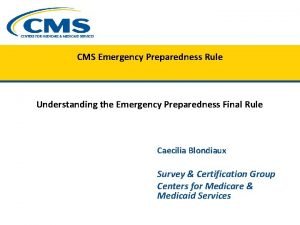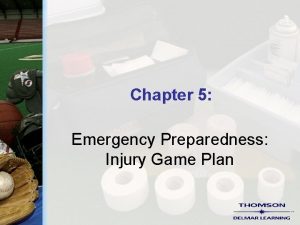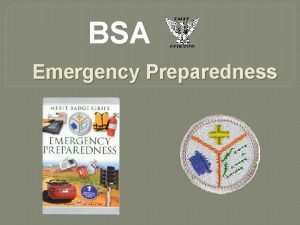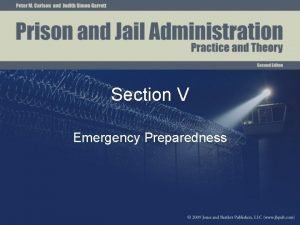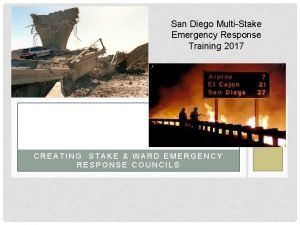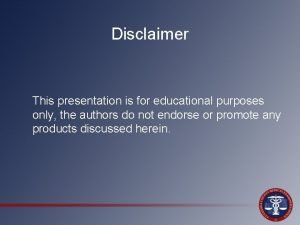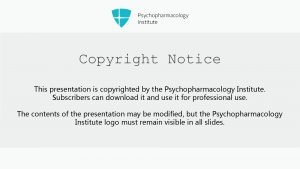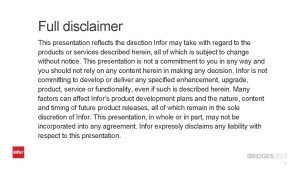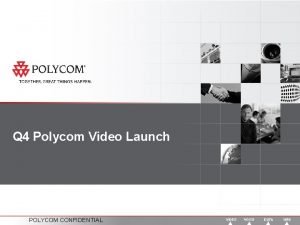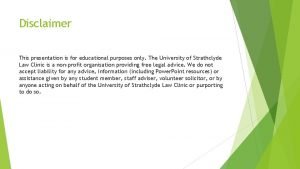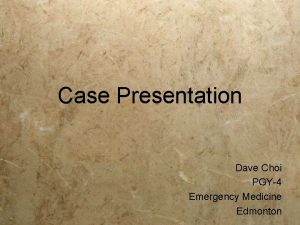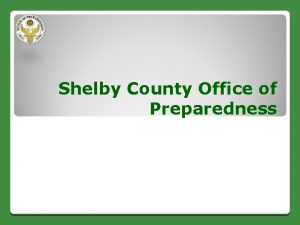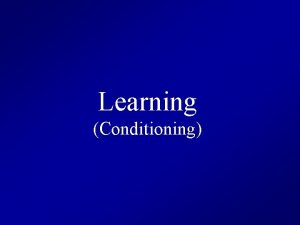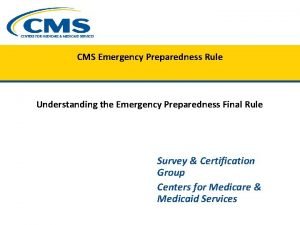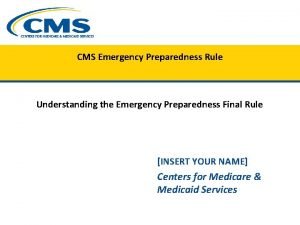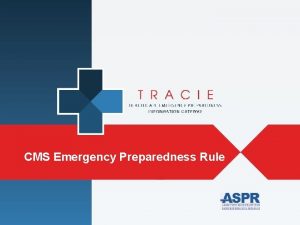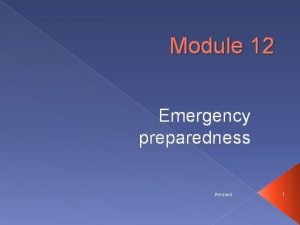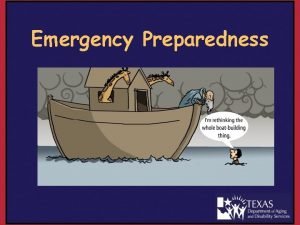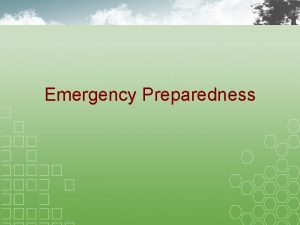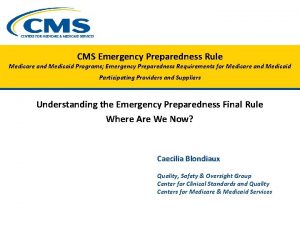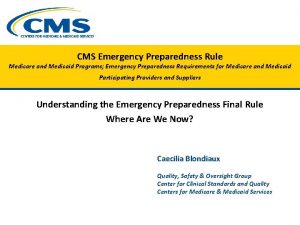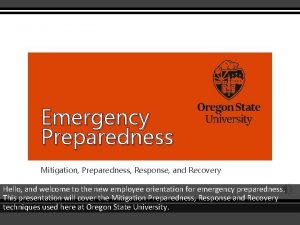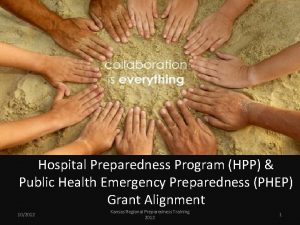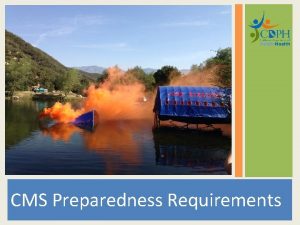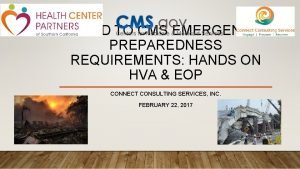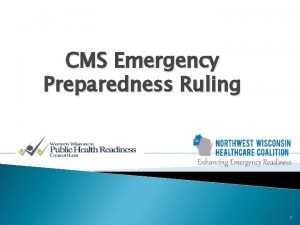CMS Emergency Preparedness Rule Disclaimer This presentation was























- Slides: 23

CMS Emergency Preparedness Rule

Disclaimer This presentation was prepared as a service to the public and is not intended to grant rights or impose obligations. This presentation may contain references or links to statutes, regulations, or other policy materials. The information provided is only intended to be a general summary. It is not intended to take the place of either the written law or regulations. We encourage readers to review the specific statutes, regulations, and other interpretive materials for a full and accurate statement of their contents. This presentation is current as of December 21, 2016. Please check asprtracie. hhs. gov/cmsrule for the most current version of this presentation.

CMS Emergency Preparedness Rule • First published in the Federal Register for comment on December 27, 2013. • Increases patient safety during emergencies. • Establishes consistent emergency preparedness requirements across provider and supplier types. • Establishes a more coordinated response to natural and man-made disasters. • Applies to 17 Medicare and Medicaid providers and suppliers. • Final rule published in the Federal Register on September 16, 2016. • Rule is effective as of November 15, 2016 • Rule must be implemented November 15, 2017

Goals for the Rule Address systemic gaps Establish consistency Encourage coordination

Conditions of Participation (Co. Ps) and Conditions for Coverage (Cf. Cs) are health and safety regulations which must be met by Medicare and Medicaid-participating providers and suppliers. • They serve to protect all individuals receiving services from those organizations. •

Four Provisions for All Provider Types Risk Assessment and Planning Policies and Procedures Emergency Preparedness Program Communication Plan Training and Testing

Who is Affected? Inpatient Outpatient Critical Access Hospitals (CAHs) Ambulatory Surgical Centers (ASCs) Hospices Clinics, Rehabilitation Agencies, and Public Health Agencies as Providers of Outpatient Physical Therapy and Speech-Language Pathology Services Hospitals Community Mental Health Centers (CMHCs) Intermediate Care Facilities for Individuals with Intellectual Disabilities (ICF/IID) Comprehensive Outpatient Rehabilitation Facilities (CORFs) Long Term Care (LTC) End-Stage Renal Disease (ESRD) Facilities Psychiatric Residential Treatment Facilities (PRTFs) Home Health Agencies (HHAs) Religious Nonmedical Health Care Institutions (RNHCIs) Hospices Transplant Centers Organ Procurement Organizations (OPOs) Programs of All Inclusive Care for the Elderly (PACE) Rural Health Clinics (RHCs) and Federally Qualified Health Centers (FQHCs)

Risk Assessment and Planning • Develop an emergency plan based on a risk assessment. • Perform risk assessment using an “allhazards” approach, focusing on capacities and capabilities. • Update emergency plan at least annually. 9

Policies and Procedures • Develop and implement policies and procedures based on the emergency plan and risk assessment. • Policies and procedures must address a range of issues including subsistence needs, evacuation plans, procedures for sheltering in place, tracking patients and staff during an emergency. • Review and update policies and procedures at least annually. 10

Communication Plan • Develop a communication plan that complies with both Federal and State laws. • Coordinate patient care within the facility, across health care providers, and with state and local public health departments and emergency management systems. • Review and update plan annually. 11

Training and Testing Program • Develop and maintain training and testing programs, including initial training in policies and procedures. • Demonstrate knowledge of emergency procedures and provide training at least annually. • Conduct drills and exercises to test the emergency plan. 12

Emergency and Standby Power Systems • Additional requirements for hospitals, critical access hospitals, and long-term care facilities. • Locate generators in accordance with National Fire Protection Association (NFPA) guidelines. • Conduct generator testing, inspection, and maintenance as required by NFPA. • Maintain sufficient fuel to sustain power during an emergency. 13

Requirements Vary by Provider Type • Outpatient providers would not be required to have policies and procedures for the provision of subsistence needs. • Home health agencies and hospices required to inform officials of patients in need of evacuation. • Long-term care and psychiatric residential treatment facilities must share information from the emergency plan with residents and family members or representatives. 14

What Happens Next? • Interpretive Guidelines and State Operations Manual developed by CMS • CMS trains surveyors • Covered entities comply with regulations

Where Can I Get More Information or Technical Assistance? • CMS • ASPR TRACIE • Healthcare Coalitions

CMS Survey and Certification Group • Developing the Interpretive Guidelines • Train the surveyors • Resources and FAQs on their website – https: //www. cms. gov/Medicare/Provider-Enrollmentand-Certification/Survey. Cert. Emerg. Prep/index. html • Email – SCGEmergency. Prep@cms. hhs. gov

ASPR TRACIE Dedicated CMS Resources Page: ASPRtracie. hhs. gov/CMSrule

Hospital Preparedness Program • The Hospital Preparedness Program (HPP) enables the health care system to save lives during emergencies that exceed day-to-day capacity of the health and emergency response systems. • This is accomplished through the development of regional healthcare coalitions (HCCs) that incentivize diverse and often competitive health care organizations with differing priorities and objectives to work together.

HPP Invests in Regional Health Care Preparedness, Response, and Recovery Capabilities through Health Care Coalitions 19

CMS Rule and HPP: Opportunities for Engaging Community Partners • HPP anticipates that health care entities that have not previously engaged in community preparedness will seek to do so through participation in HCCs. • The CMS rule offers HCCs and newly engaged providers a tremendous opportunity to achieve greater organizational and community effectiveness and financial sustainability through a more inclusive preparedness community. • Although the over 26, 000 health care organizations already engaged in community preparedness through HCCs may already meet or exceed the baseline level of preparedness in the CMS rule, HCCs will also function as an accessible source of preparedness and response best practices as newly engaged provider types adapt to the new requirements.

Final Rule Implementation • Timeline – Don’t wait until the last minute! – Effective November 15, 2016 – Implementation November 15, 2017

Link to the Final Rule • Access the final rule at: https: //www. regulations. gov/document ? D=CMS-2013 -0269 -0377 15

Resources for More Information • ASPR TRACIE – asprtracie. hhs. gov/cmsrule – askasprtracie@hhs. gov • CMS SCG – https: //www. cms. gov/Medicare/Provider. Enrollment-and. Certification/Survey. Cert. Emerg. Prep/index. ht ml – SCGEmergency. Prep@cms. hhs. gov
 Cms emergency preparedness final rule
Cms emergency preparedness final rule Chapter 5 emergency preparedness injury game plan
Chapter 5 emergency preparedness injury game plan Chapter 36 emergency preparedness and protective practices
Chapter 36 emergency preparedness and protective practices Bsa emergency preparedness
Bsa emergency preparedness National radiological emergency preparedness conference
National radiological emergency preparedness conference Chapter 36 emergency preparedness and protective practices
Chapter 36 emergency preparedness and protective practices Stake emergency preparedness plan
Stake emergency preparedness plan Presentation disclaimer examples
Presentation disclaimer examples This information is for educational purposes only
This information is for educational purposes only Presentation copyright disclaimer
Presentation copyright disclaimer Disclaimer for presentation
Disclaimer for presentation Disclaimer investor presentation
Disclaimer investor presentation Slide todoc.com
Slide todoc.com What is polycom
What is polycom Disclaimer for educational purposes only example
Disclaimer for educational purposes only example Presentation copyright disclaimer
Presentation copyright disclaimer Confidentiality disclaimer presentation
Confidentiality disclaimer presentation Pixabay
Pixabay Emergency medicine case presentation
Emergency medicine case presentation Answer site
Answer site Dog bite pictures
Dog bite pictures Shelby county office of preparedness
Shelby county office of preparedness Skinner box
Skinner box Conditioning learning
Conditioning learning
